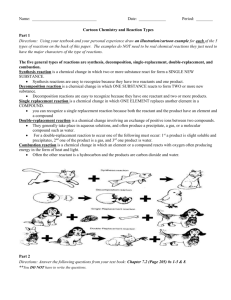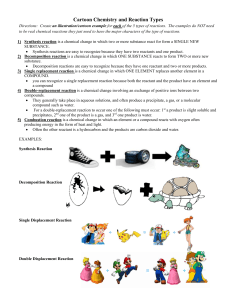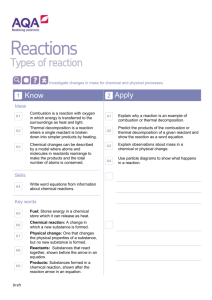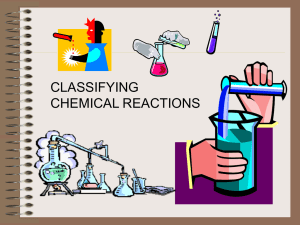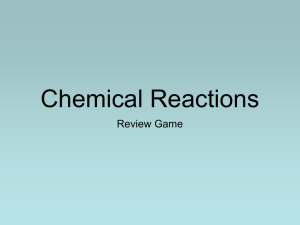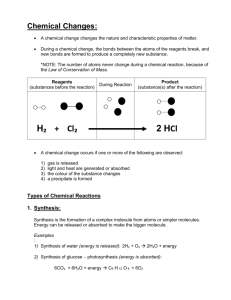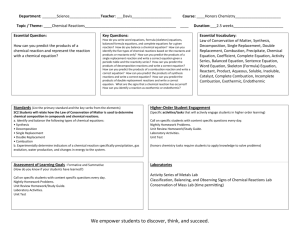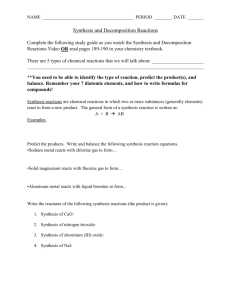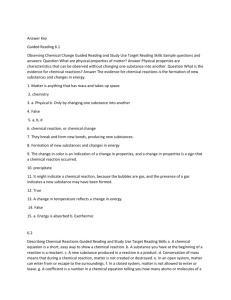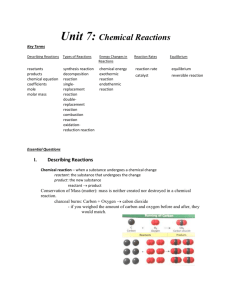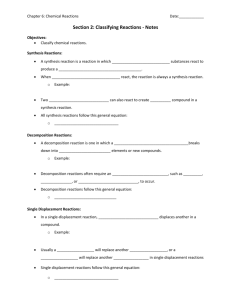Name: Date: Period: ______ Unit 11: Chapter 7
advertisement
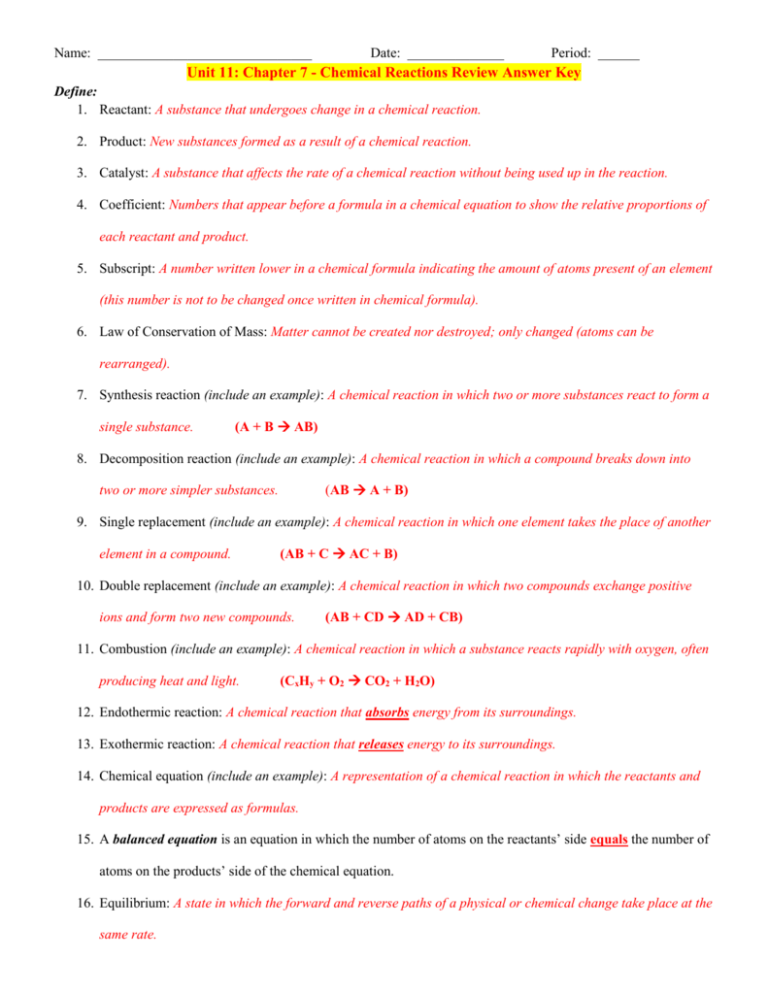
Name: _______________________________ Date: ______________ Period: ______ Unit 11: Chapter 7 - Chemical Reactions Review Answer Key Define: 1. Reactant: A substance that undergoes change in a chemical reaction. 2. Product: New substances formed as a result of a chemical reaction. 3. Catalyst: A substance that affects the rate of a chemical reaction without being used up in the reaction. 4. Coefficient: Numbers that appear before a formula in a chemical equation to show the relative proportions of each reactant and product. 5. Subscript: A number written lower in a chemical formula indicating the amount of atoms present of an element (this number is not to be changed once written in chemical formula). 6. Law of Conservation of Mass: Matter cannot be created nor destroyed; only changed (atoms can be rearranged). 7. Synthesis reaction (include an example): A chemical reaction in which two or more substances react to form a single substance. (A + B AB) 8. Decomposition reaction (include an example): A chemical reaction in which a compound breaks down into (AB A + B) two or more simpler substances. 9. Single replacement (include an example): A chemical reaction in which one element takes the place of another element in a compound. (AB + C AC + B) 10. Double replacement (include an example): A chemical reaction in which two compounds exchange positive ions and form two new compounds. (AB + CD AD + CB) 11. Combustion (include an example): A chemical reaction in which a substance reacts rapidly with oxygen, often producing heat and light. (CxHy + O2 CO2 + H2O) 12. Endothermic reaction: A chemical reaction that absorbs energy from its surroundings. 13. Exothermic reaction: A chemical reaction that releases energy to its surroundings. 14. Chemical equation (include an example): A representation of a chemical reaction in which the reactants and products are expressed as formulas. 15. A balanced equation is an equation in which the number of atoms on the reactants’ side equals the number of atoms on the products’ side of the chemical equation. 16. Equilibrium: A state in which the forward and reverse paths of a physical or chemical change take place at the same rate. Complete the following statements. 17. A reaction where the temperature is known to be high is a(n) exothermic reaction. 18. A chemical reaction that produces only one product is synthesis. 19. A chemical reaction that starts with only one reactant and forms two products is decomposition. 20. A chemical reaction that absorbs energy is endothermic. 21. The general formula A + BC AC + B illustrates a single- replacement reaction. 22. The arrow in a chemical reaction can mean produces, yields or forms. 23. A reaction that starts and ends with two compounds is double-replacement. 24. A catalyst is a substance that is not used up in a reaction. 25. In a compound, energy is contained in the chemical bonds. 26. The burning of a candle is an example of a combustion reaction. 27. In order to follow the Law of Conservation of Mass if you start with 98 grams of reactant you must end with 98 grams of product. 28. Write the coefficients of the two (2) following balanced equations on the lines provided. 2NaCl + F2 2NaF + Cl2 2, 1, 2, 1 2Ag2O 4Ag + O2 2, 4, 1 Identify the type of reaction and balance the following reactions. You MUST show your element inventory. 1. ____P4 +_6_ Br2 _4_ PBr3 Type: Synthesis 2. _2_ Fe _2_ FeCl Type: Synthesis _3_ Cl 3. ___ AlBr3 + _3_ K 4. _2_ H O _3_ KBr + ____Al _2_ H O 5. ___ PbBr2 + _2_ HCl 6. ___ N2 + _3_ H2 7. _2_ Na +_____ Br2 _____O _2_ HBr + ___ PbCl2 _2_ NH _2_ NaBr Type: Single-replacement Type: Decomposition Type: Double-replacement Type: Synthesis Type: Synthesis 8. ___ AlCl + _3_ NaOH 9. _2_ Na3P + _3_ CaF2 10. ___CH4 + _2_ O2 ____ Al(OH) 3 _3_ NaCl _6_ NaF + ____ Ca3P2 _2_ H2O +____ CO2 Type: Double-replacement Type: Double-replacement Type: Combustion
